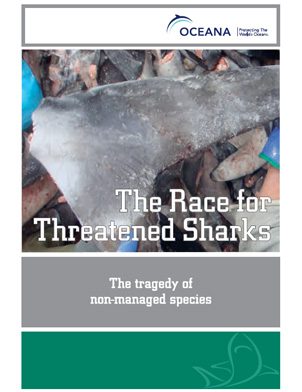Report | July 22, 2010
The race for threatened sharks
Sharks are extremely vulnerable species which have been fished by European Union vessels at home and around the world without any management for decades. Globally, 21% of shark, ray and chimaera populations are threatened with extinction according to the IUCN Red List. In the Northeast Atlantic the figure is even higher with 26% threatened and in the Mediterranean this figure goes up to 42%.
Smaller and artisanal European Union vessels catch sharks and rays in home waters of the Northeast Atlantic and Mediterranean Sea. Species like small spotted cat sharks (Scyliorhinus canicula), spurdogs (Squalus acanthias) and rays (Rajidae) are caught close to shore in nearly every coastal EU country. However, more and more sharks are also being caught far away from home by large commercial fleets. For example, French industrial bottom trawlers and Spanish and English industrial deep-sea gillnetters catch deep-sea sharks in the Northeast Atlantic, and large Spanish and Portuguese longliners catch highly migratory sharks in international waters and waters of African and Pacific nations. Therefore, management of the EU’s shark fisheries must not only encompass
European Union waters, but also international waters, the Mediterranean and coastal zones of African, Asian and South American countries.
Sharks are often hunted in targeted commercial fisheries, particularly for their valuable fins. Some species, whether targeted or caught as by-catch, are categorized as Vulnerable, Endangered or Critically Endangered according to the IUCN Red List, like hammerhead sharks (Spyhrna spp.), thresher sharks (Alopias spp.) and porbeagles (Lamna nasus). To date, a few shark species, like deep-sea sharks, are managed in European waters but there is not are not any catch limits for highly migratory sharks like blue sharks (Prionace glauca) and mako sharks (Isurus spp.), neither in European nor third country nor international waters.
Management tools for shark conservation include traditional fisheries management, biodiversity convention protection, and trade measures. In March 2009, Oceana published the report “Keeping the Balance” to point out which environmental law instruments can be used to protect sharks.5 As a compliment to that report, this one provides an overview of existing shark management and conservation under European fisheries laws, and shows which additional fisheries measures must be taken, in Europe and internationally, to prevent further depletion of shark and ray populations.


